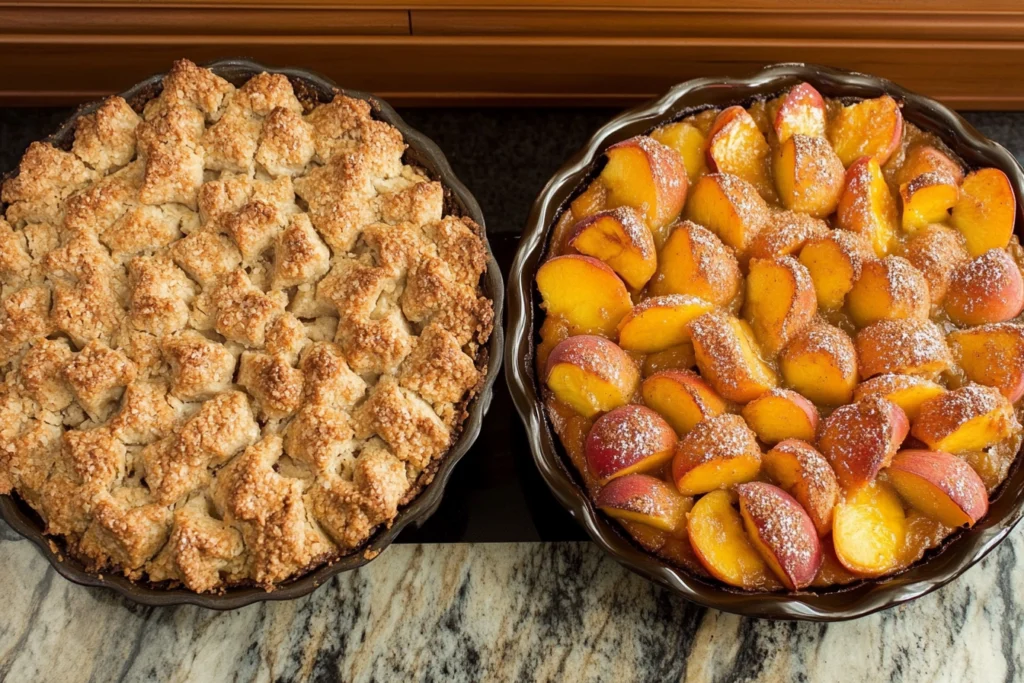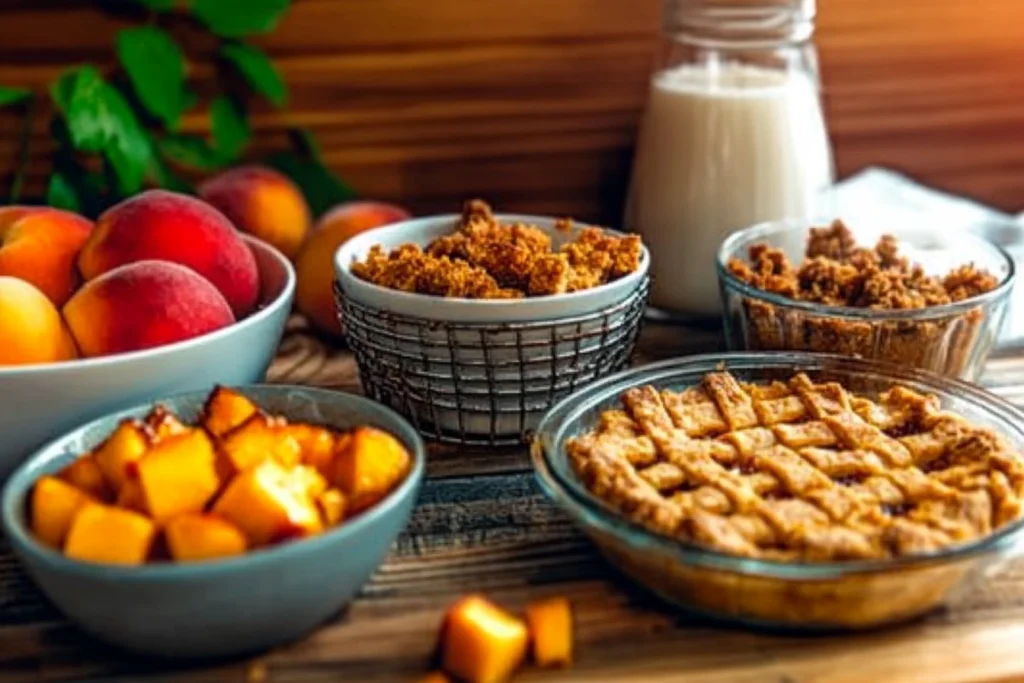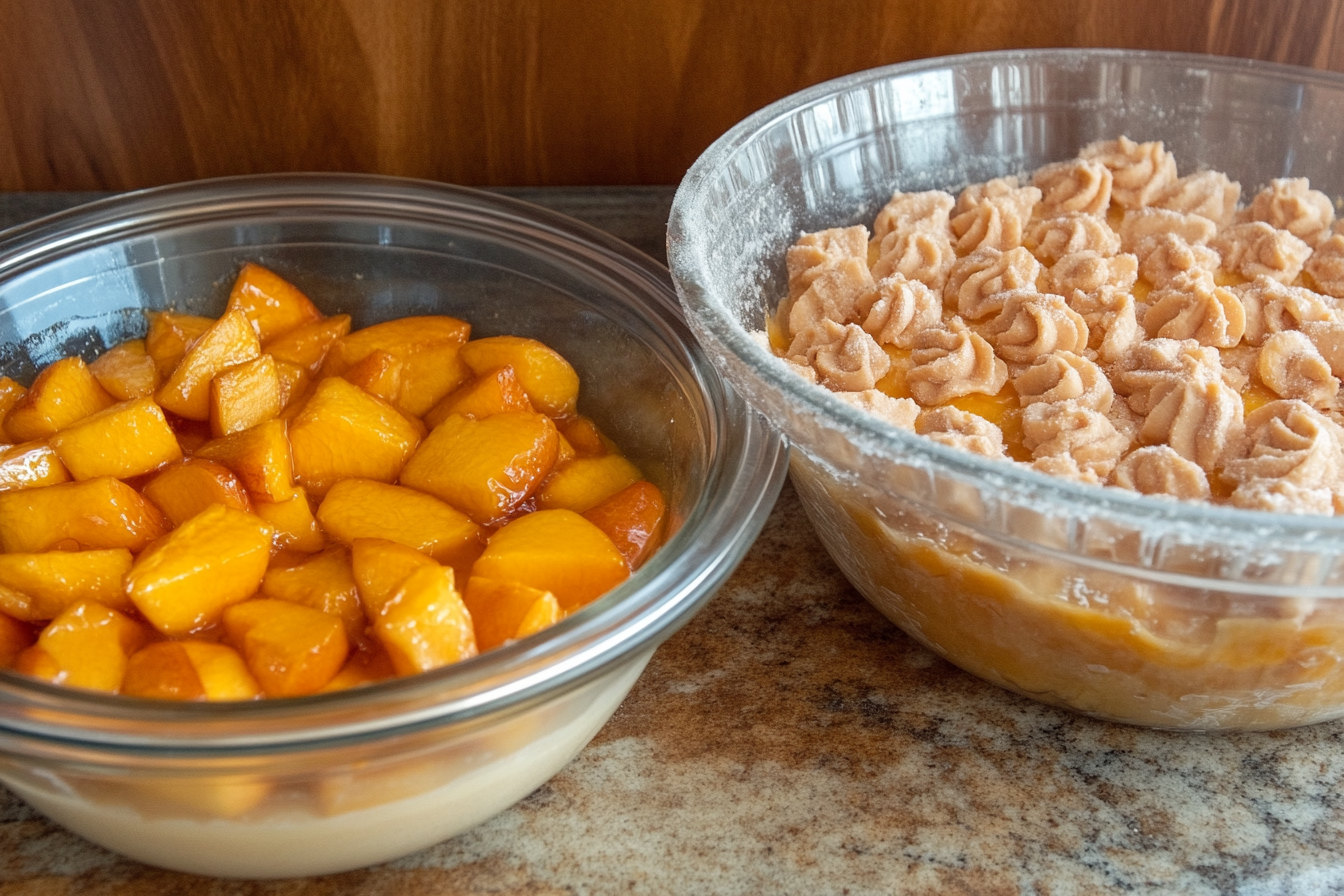Peach desserts hold a cherished spot in culinary traditions, particularly in American cuisine. Among the most beloved are the peach pie and the peach cobbler. These treats may seem similar to the untrained eye, but their differences are as distinct as their flavors. Understanding what sets them apart allows us to appreciate their unique charms. Let’s delve into the heart of these delectable desserts.
Understanding the Basics of Peach Desserts
Before diving into the contrasts, it’s essential to define the stars of our discussion: the peach pie and the peach cobbler. These desserts, while sharing the same key ingredient—juicy peaches—stand apart in preparation, presentation, and flavor.
What is a Peach Pie?
A peach pie is a classic dessert consisting of a flaky crust encasing a sweet and tangy peach filling. Traditionally, it features:
- A double crust: one layer beneath the filling and another on top.
- A filling made of peaches, sugar, spices, and sometimes a thickener like cornstarch or flour.
The hallmark of a peach pie is its structured form. The crust provides a stable shell that holds the filling, creating neat, elegant slices when served.
What is a Peach Cobbler?
A peach cobbler, on the other hand, is more rustic in its appearance and preparation. This dessert skips the bottom crust and instead relies on a topping. Common variations include:
- Biscuit-style dough
- A cake-like batter
- A crumbly streusel topping
The peach cobbler is baked with the fruit filling at the bottom, allowing the topping to soak up the fruit’s juices as it cooks. The result? A dessert that’s juicy, soft, and bursting with flavor.
Historical Background of Peach Pies and Cobblers
Understanding their origins helps illuminate the roles of peach pies and peach cobblers in culinary traditions.
The Origins of Pie as a Dessert
The concept of pie dates back to ancient civilizations, with variations appearing in Greece, Rome, and medieval Europe. Early pies were more savory than sweet, but over time, fruit pies like peach pie became synonymous with indulgent desserts. The combination of a flaky crust and sweet filling solidified pies as a symbol of home-baked goodness.
The Role of Cobblers in American History
Cobblers have a distinctly American heritage. They emerged from necessity as settlers adapted European recipes to the ingredients and tools available in the New World. Without proper ovens, early bakers created desserts like cobblers, where fruit was topped with simple doughs and baked over an open flame. This innovation made cobblers an enduring symbol of ingenuity and comfort.

Why Compare Peach Pie and Peach Cobbler?
While both desserts celebrate the natural sweetness of peaches, their differences make each more suitable for specific occasions and preferences.
Common Confusions Between the Two
Because both use peaches as their base, the peach pie and peach cobbler are often confused. However, their differences go beyond the surface:
- Structure: Pie has a rigid crust; cobbler does not.
- Topping: Pies have a uniform crust on top, while cobblers feature varied, often crumbly toppings.
When to Choose One Over the Other
The choice between peach pie and peach cobbler often boils down to the context:
- Peach Pie: Perfect for formal occasions where presentation matters.
- Peach Cobbler: Ideal for casual gatherings and comforting meals.
Structural and Ingredient-Based Differences
When comparing peach pie and peach cobbler, their distinctions become even clearer in terms of structure, ingredients, and texture. Each dessert brings its unique identity to the table, offering diverse culinary experiences for different occasions.
Crust and Topping Variations
The most visible difference between peach pie and peach cobbler lies in their crusts and toppings. These elements define the texture and overall presentation of the dessert.
Peach Pie: The Double Crust Classic
A hallmark of the peach pie is its double crust, which provides structure and visual appeal. Key features include:
- Bottom Crust: A base layer of dough supports the filling, ensuring each slice retains its shape.
- Top Crust Options: Traditional pies often feature a solid top crust, a lattice pattern, or decorative cutouts.
- Flaky Texture: Achieved through a careful balance of butter, flour, and chilling techniques.
This combination creates a dessert that is both elegant and sturdy, ideal for cutting into picture-perfect slices.
Peach Cobbler: Biscuits, Batter, or Crumble Topping
In contrast, peach cobbler replaces the structured crust with a variety of toppings. These range from crumbly streusels to biscuit-style layers or cake-like batters. Each type of topping brings its own character:
- Biscuit Topping: Offers a golden, flaky texture reminiscent of Southern comfort food.
- Cake Batter: Produces a soft, spongy topping that absorbs peach juices for a moist finish.
- Streusel or Crumb Topping: Adds sweetness and a crispy texture, perfect for those who enjoy contrast in every bite.
The absence of a bottom crust allows the cobbler to embrace a more rustic, less formal aesthetic.

Base and Filling Preparation
Another key difference is how the peach filling interacts with the crust or topping, altering the final texture and taste.
Peach Pie: Encased Filling in a Baked Crust
In a peach pie, the filling is neatly encased within the crust. This creates a self-contained dessert where:
- The peach mixture—sweetened and often thickened with cornstarch or flour—becomes slightly set during baking.
- Even Distribution: The filling remains evenly layered, preventing any spillage.
This encasing ensures the filling retains its integrity, giving each bite a balance of fruit and flaky crust.
Peach Cobbler: Filling Layered with Topping
For peach cobbler, the fruit filling is spread across the bottom of the dish, with the topping added directly over it. This approach results in:
- Juicier Filling: The topping absorbs excess juices, blending flavors.
- Layered Texture: Each spoonful features a mix of soft fruit and crispy or crumbly topping.
The looser structure of cobbler makes it less suitable for slicing but perfect for scooping.
Ingredient Differences
The choice of ingredients plays a significant role in defining the peach pie and peach cobbler. From dough to toppings, these desserts require different components to achieve their signature results.
Flour and Dough Use in Peach Pies
The dough used for a peach pie demands precision and care. Key elements include:
- Pie Dough: Made from flour, butter (or shortening), and water, it must be chilled and rolled out evenly.
- Thickeners: Flour or cornstarch is often added to the peach filling to ensure it doesn’t become too runny.
This attention to detail is what gives pies their hallmark crispness and structure.
Diverse Toppings in Peach Cobblers
In contrast, cobbler toppings are more forgiving and versatile. Ingredients might include:
- Self-Rising Flour: Simplifies the process for biscuit or batter toppings.
- Butter and Sugar: Add richness and sweetness to the topping.
- Oats or Nuts: For a textured, streusel-like finish.
This flexibility allows cobblers to cater to a broader range of tastes and dietary preferences.
Sweetness and Texture Profiles
The sensory experience of eating peach pie versus peach cobbler also sets them apart. Their differing sweetness levels and textures create unique flavor profiles.
The Firm Texture of a Peach Pie
The structured nature of a peach pie gives it a firmer texture that holds up well under the knife. Highlights include:
- Balanced Sweetness: The double crust often tempers the sweetness of the filling, creating a well-rounded flavor.
- Crispness: The flaky crust provides a delightful contrast to the soft peach filling.
This makes peach pie a popular choice for those who appreciate a dessert with defined layers and consistency.
The Softer, More Rustic Texture of a Cobbler
On the other hand, peach cobbler offers a softer, more casual texture. Its characteristics include:
- Juicy Filling: The lack of a bottom crust allows the peaches to release their natural juices, enhancing the dessert’s flavor.
- Rustic Appeal: The topping, whether crumbly or biscuit-like, adds a homemade charm.
Cobblers are the epitome of comfort food, with a texture that invites indulgence.
Preparation and Presentation Distinctions
Peach pie and peach cobbler have distinctive preparation methods and serving styles that highlight their unique characteristics. These differences further influence how each dessert is perceived and enjoyed.
Cooking Techniques
The preparation processes for peach pie and peach cobbler reveal notable contrasts in complexity and precision.
Baking Time and Temperature Differences
- Peach Pie:
- Requires a baking time of 45–60 minutes, ensuring the crust becomes golden and the filling sets.
- The pie often demands preheating the oven to higher temperatures (375–425°F), depending on the recipe.
- Blind baking the bottom crust may be necessary to prevent sogginess.
- Peach Cobbler:
- Cooks faster, typically in 30–40 minutes, due to the absence of a bottom crust.
- Baking temperatures are slightly lower (350–375°F), allowing the topping to bake evenly while preserving the fruit’s juiciness.
How Peach Pies Require More Precision
The structured nature of peach pie demands meticulous preparation:
- The dough must be carefully rolled and fitted to avoid tearing.
- Thickeners like cornstarch or tapioca are added to the filling to ensure it holds its shape.
- Decorative top crusts, such as lattice designs, require skill and time.
Peach cobbler, on the other hand, is forgiving and relies on minimal techniques, making it an easier option for novice bakers.
Serving Suggestions
The serving styles of peach pie and peach cobbler reflect their inherent characteristics, from elegant slices to rustic scoops.
Peach Pie: Elegant and Structured Presentation
- Sliced for Precision: A peach pie is served in triangular slices, showcasing the layered crust and filling.
- Accompaniments:
- A dollop of whipped cream.
- A scoop of vanilla or peach ice cream.
- A drizzle of caramel or a light dusting of powdered sugar for added flair.
Peach Cobbler: Rustic and Casual Appeal
- Served in Scoops: Cobbler is typically served straight from the dish, embracing its relaxed, homey charm.
- Perfect with Ice Cream:
- Warm cobbler pairs exceptionally well with vanilla or cinnamon ice cream.
- Alternatively, a splash of heavy cream enhances the juicy filling.
Its casual style makes peach cobbler a favorite for family meals, picnics, and potlucks.
Regional and Cultural Variations
The popularity of peach pie and peach cobbler is often shaped by cultural influences and regional preferences.
Peach Pie: A Timeless American Classic
- Widely associated with holidays such as Thanksgiving and Christmas, peach pie is a symbol of tradition and celebration.
- Its polished appearance and complex preparation make it a common choice for formal events.
- In regions like the Midwest and Northeast, peach pie represents a quintessential summer dessert when peaches are in season.
Peach Cobbler: A Southern Staple
- Deeply rooted in Southern cuisine, peach cobbler embodies warmth and hospitality.
- Its simplicity and heartiness make it a staple at barbecues, church socials, and family reunions.
- Variations, such as adding spices like cinnamon or nutmeg, reflect regional tastes and cultural heritage.
Practicality and Time Considerations
Choosing between peach pie and peach cobbler often comes down to the time and effort available for preparation.
Quick and Easy: Peach Cobbler
- Simplified Process: No rolling or shaping of dough is needed.
- Flexible Ingredients:
- Canned or frozen peaches can be used when fresh peaches aren’t available.
- Self-rising flour and basic pantry items make the topping quick to assemble.
- Minimal Cleanup: All ingredients are mixed and baked in one dish.
For those with tight schedules or unexpected guests, cobbler is the go-to option.
Time-Intensive Craftsmanship: Peach Pie
- Labor of Love: Crafting the perfect pie crust takes time, including chilling, rolling, and shaping.
- Aesthetic Appeal: The visual beauty of a lattice or decorative crust is worth the extra effort.
- Longevity: A pie’s structured design helps it stay fresh longer, making it a good choice for occasions where the dessert might sit out.
Peach pie’s detailed preparation may require more effort, but the result is a dessert that impresses with its beauty and flavor.
FAQs: Peach Pie vs. Peach Cobbler
- Can I use frozen peaches for both desserts? Absolutely! Frozen peaches work well for both recipes and save preparation time.
- What is the best topping for peach cobbler? Biscuit-style dough, cake batter, or streusel are all excellent options, depending on your preference.
- How do I prevent a soggy pie crust? Blind baking and using a thickener in the filling can help keep the crust firm.
- Should I peel the peaches? Peeling is optional, but removing the skins gives a smoother texture, especially in pies.
- Can I make peach cobbler gluten-free? Yes, substitute the flour with a gluten-free blend and adjust liquid ratios if needed.
- What spices pair best with peaches? Cinnamon, nutmeg, ginger, and even a hint of vanilla or almond extract complement peaches beautifully.
- Is cobbler healthier than pie? Cobblers often have fewer calories because they lack a double crust, but this depends on the recipe.
- Can I prepare these desserts ahead of time? Yes. Pies can be made a day in advance, while cobblers are best baked fresh but can be reheated.
- How do I store leftovers? Both can be stored in the refrigerator for up to 3–4 days; pies freeze well, while cobblers should be consumed sooner.
- What is the key difference in taste? Pie has a firmer, more structured bite due to the crust, while cobbler is juicier and more rustic with a softer texture.

